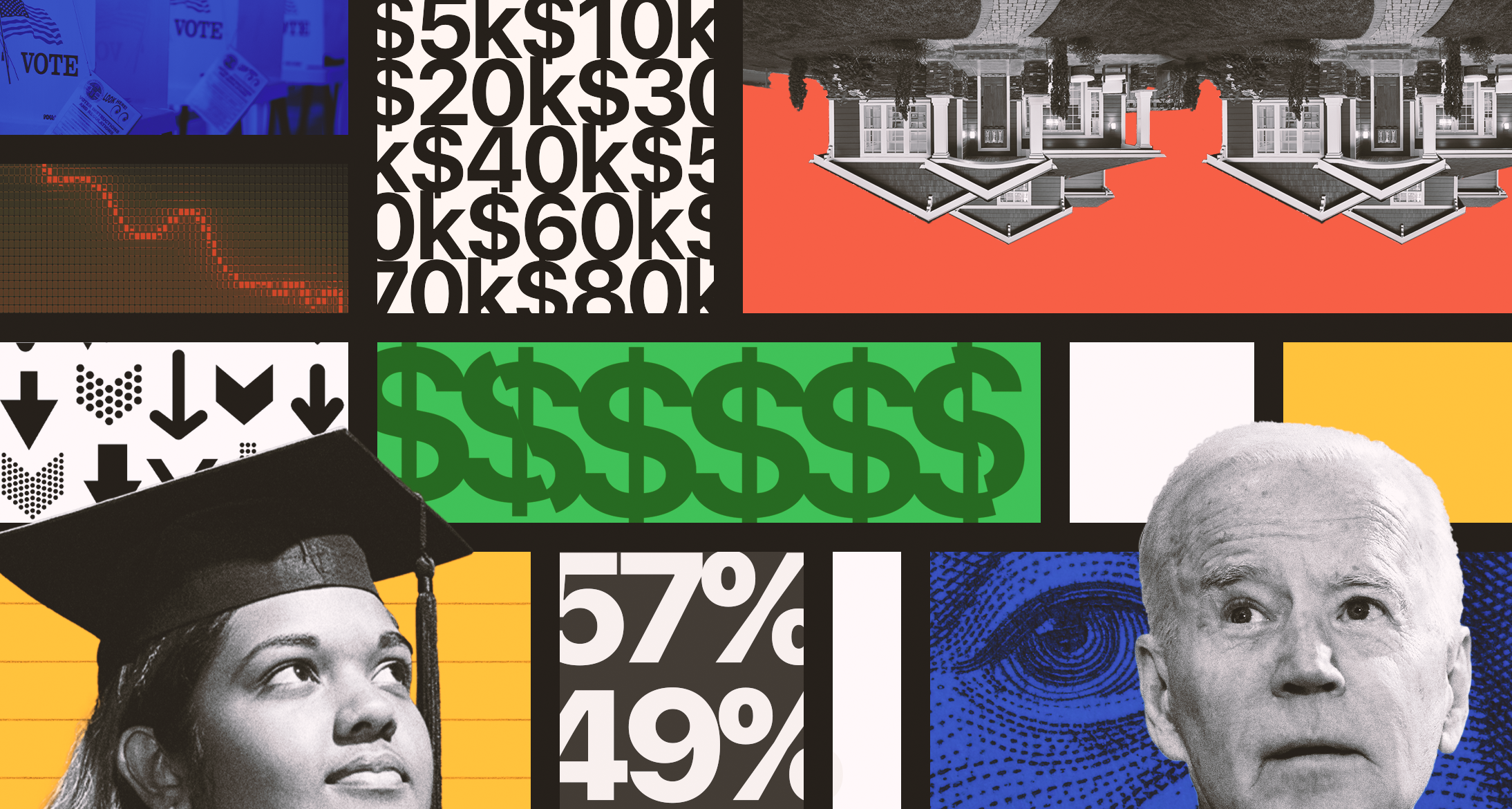This article originally appeared on our substack
On Thursday, the White House signaled that action is imminent on permanent student loan relief as Biden announced he expects to make a decision “in the next couple of weeks.” The administration had already extended the pandemic-era student loan moratorium until August 31.
The White House is apparently considering income ceilings on eligibility: a cap of up to $150k for individuals and up to $300k for couples. Biden told reporters that the total amount forgiven per borrower would be at or above the $10k he’s previously promised but below the $50k that progressives such as AOC and Warren have been calling for. The administration is also apparently weighing limiting forgiveness to undergraduate loans, excluding those who took out loans for professional degrees like law and medicine.
As we gear up for Biden’s announcement, let’s look at the cases for and against relief. I’ll conclude by sharing where I come down on the issue.
The Case For Student Debt Relief
Debt is crippling a generation. The total amount of student debt owed in this country has more than doubled since 2008, now totaling at least $1.7 trillion. More students owe more debt than ever before. The amount of households with student debt has tripled — from 8% in 1989 to 21% in 2021 — while the average quantity of such debt owed by households increased nearly four-fold in real terms from 1989 to 2019. This forces people to delay or forgo major life decisions such as purchasing a house, starting a family, or launching a business.
Government created this crisis; government should solve it. “Government has been acting like a predatory lender,” argued Slate’s Jordan Weissman on a recent episode of the Plain English podcast. “They give out loans indiscriminately, they don’t check credit scores, and they don’t even ask questions about the kinds of schools you’re going to.” Borrowers from for-profit colleges hold on average 40% more debt and are twice as likely to default. The government has made it as easy as possible for these for-profits to prey on vulnerable customers and has done next to nothing to control costs or discriminate on the basis of quality of program or major. This dynamic is also at play in non-profit and public colleges as well, where, as Dominic Pino and many others have argued, the government restricted supply (making it hard to start a university) while manufacturing demand. To make matters worse, the government also makes it extremely difficult to discharge student loan debt in bankruptcy.
The vulnerable suffer the most. On average, women owe nearly $3k, or 10%, more student debt than men. Black borrowers owe over $13k, or nearly 50%, more than white borrowers and are twice as likely to default. One report from the US Department of Education found that “the typical African American student who started in the 2003-04 school year and took on debt for their undergraduate education owed more on their federal student loans than they originally borrowed.” As Elizabeth Warren has argued, “canceling student debt would substantially increase Black household wealth, help close the racial wealth gap, and help them avoid default.”
Students with debt are more likely to overwork and sell out. Multiple studies have shown that student debt pushes graduates to choose work they are less passionate about and deters them from public interest careers that offer lower salaries than corporate work. A study in the Economics of Education Review revealed that recent graduates with student debt take jobs that have higher initial salaries but lower potential wage growth. And while those with student loans have higher incomes, they don’t have statistically significant higher hourly wages, suggesting that student debt is forcing loan holders to work longer hours.
It’s good politics. Biden’s support among young voters, especially young voters of color, has been dropping significantly over the past year. This is an emergency for the administration. Young voters delivered Biden his widest margins in 2020, and he’s going to need them in 2024. He started his term with around 60% approval among 18-to-34-year-olds, but his support has tanked by somewhere between 13 and 24 points, depending on the survey. A January poll found that 64% of young people supported Biden’s extension of the loan moratorium and 53% supported either canceling all student loan debt or forgiving up to $50k. Another 9% supported forgiving up to $10k. Biden must take dramatic action to flip perceptions, and this is one of the few options he has that may (emphasis on *may* — more on this below) not require congressional action.
The Case Against Student Debt Relief
Student loan forgiveness is regressive. Less than 20% of the approximately 250 million adults in the US have student loans, and most of them are in the top 50% of earners. That’s because college graduates turn out to have high incomes. And while only 25% of those with student loans went to graduate school, they owe around 50% of all student debt. Those graduate degree-holders make, on average, over $1 million more in a lifetime than high school graduates. Is it really fair to use a blue collar worker to pay off the debt of a white collar worker who earns significantly more?
Biden doesn’t have the authority. Proponents of debt relief, including Elizabeth Warren, believe that the Higher Education Act of 1965 gives Biden the power to unilaterally cancel all student debt. They cite an obscure provision from the Act that gives the Department of Education the ability to settle or forgive an unspecified amount of student debt. The law doesn’t put a cap on how much can be forgiven and doesn’t offer much in the way of other details on when or how the provision should be applied. Biden himself has signaled that he believes the provision has limits, saying he’s “prepared to write off $10k in debt, but not 50 because I don’t think I have the authority to do it by signing [an executive order.]” It’s unclear why he thinks the law would give him the ability to cancel some, but not all debt. Nancy Pelosi has said Biden doesn’t have the authority to cancel any student debt. Then, of course, there’s the Supreme Court, which, in its recent vaccine mandate cases, signaled increasing skepticism of the federal government using vague statutes to justify sweeping policy change. To use a metaphor from the late Justice Antonin Scalia, pushing through debt relief in this way would be like pushing an “elephant through a mouse hole.”
This move would do nothing to solve the underlying causes of the crisis. A one-time forgiveness won’t decrease the costs of college, drive borrowers to high quality programs, or place students in professions that our society needs.
We’ve already canceled significant debt. Due to the existing moratorium, the Committee for a Responsible Federal Budget has estimated that $5.5k per borrower has been effectively canceled already, from the lack of interest that would have accumulated on existing debt. This may not be an argument against forgiving debt in general, but it could be used to persuade officials to hew closer to the $10k forgiveness target instead of the $50k.
It’s unfair to those who’ve already paid off their debt. Over 34 million people have paid off their student loans entirely. What message are we sending them and to future people like them? Is there a way to apply forgiveness retroactively? Could we even afford that?
The politics are actually not good. It’s easy to imagine the conservative talking points about liberals siphoning money from the pockets of blue collar Americans and sending it to elite college graduates. “This is who the Democratic base is — upwardly mobile urban professionals with high incomes,” argues Brian Riedl, an analyst at the Manhattan Institute, a conservative think tank. “Subsidizing college graduates with often expensive graduate degrees is really going to offend those who did not go to college, as well as those who paid off their student loans.” About 58% of the 2020 Biden electorate graduated from a four-year college or university, well above the national average and up from 2012 figures. “Given that trend,” argued Jerusalem Demsas in a recent Atlantic piece, “student-loan forgiveness may seem like the classic tale of a political party transferring a valuable benefit to a crucial constituency.”
We’re overselling how helpful this would be to Black borrowers. The majority of student loan debt is held by white borrowers, as just 23% of Black Americans older than 24 had a college degree in 2019. Here’s Jerusalem Demsas again:
Across the board, student-loan advocates have centered racial justice in their demands for loan forgiveness. They cite a variety of statistics showing that Black college graduates have more student-loan debt than their white counterparts, and that they pay off their loans at a slower rate than white graduates. But the former simply reveals that Black Americans are on average poorer than white Americans, and the latter is likely because of labor-market discrimination, neither of which is addressed by student-loan cancellation. Student-debt cancellation does not actually change anything about labor-market discrimination or credit-market discrimination or discrimination within institutions of higher education, nor does it address the rising cost of college.John Doe
My Take
Some form of debt forgiveness is inevitable, even as it may eventually be struck down by the courts. If we’re going to forgive debt, I agree with the Biden administration’s moves to means-test relief and to cap the total amount forgiven in most cases (though I’d probably set my caps lower than they’ve proposed). That would go a long way in ensuring that wealthy borrowers — like Ivy League lawyers — don’t benefit from his moves.
However, to quote Rahm Emmanuel, we shouldn’t “let a good crisis go to waste.” We should use debt forgiveness to attempt to solve structural problems in our higher education system. To start, Biden should — either through executive order or legislation — restrict future federal loans to institutions that have a strong track record of keeping costs down, growing their student populations, and producing employable graduates.
I would also make an exception and forgive all total debt — with no means testing — for certain essential professions that are in short supply, such as teachers, social workers, doctors, and nurses. Estimates suggest that canceling loans for social workers would cost around $18 billion and deliver relief to roughly 400k people; and for teachers, it would cost $117 billion, leaving another 3 million people debt-free. Doctors and nurses would cost around $250 billion and would directly benefit roughly 1 million people. I would make these profession-based incentives permanent and would, in perpetuity, forgive loans to people working 10+ years in each of those fields. Biden could even package this move as a form of national service, something that could inspire future generations to give back.
As for the politics, the above-described moves would mitigate the political risks for Biden by making relief less regressive. And let’s face it: Biden has nothing to lose and everything to gain. His presidency is in a crisis with historically low approval ratings across the board. He may as well go bold and let the chips fall where they may.
Of course, the albatross hovering over every borrower is the Supreme Court. They could easily kill this dream with one stroke of a pen, but it’s worth trying.




